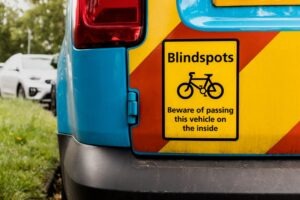
A truck’s no-zone, or its blindspot, isn’t one spot but four. There are four areas around a truck that a driver cannot see when behind the wheel, even with the help of their mirrors. Drivers must look over their shoulders or rely on cab-based technologies to help them determine whether or not people are in these “no-zones.”
Drivers who don’t make a point to check their blindspots can, unfortunately, cause devastating accidents. Victims of no-zone truck accidents have the right to file personal injury claims against negligent truck drivers, but only if they can prove that their accident stemmed from a truck driver’s inattention or deliberate recklessness.
Our Indianapolis truck accident lawyers can help survivors like you break down the logistics of a recent blindspot accident. This way, you can determine whether or not you have the right to take action against a negligent driver.
Identifying a Truck’s No-Zones
Independent drivers have an obligation to protect themselves from avoidable danger while they’re on the road. One of the best ways to do so is to acknowledge that other vehicles, including trucks, have blind spots that you need to accommodate. Blind spots, or “no-zones,” are inherently dangerous to linger in for too long.
Trucks, being considerably larger than the average passenger car, have four no-zones that you should make an effort to avoid. Drivers cannot see what’s going on:
- 30 feet behind their trucks
- 20 feet in front of their trucks
- One lane to the left of their trucks
- Two lanes to the right of their trucks
While you’re not in control of how a truck driver operates their vehicle, you can take steps to stay out of these blind spots while passing a truck on Indiana’s interstates. Your efforts can prevent accidents that might otherwise prove physically, emotionally, and financially devastating.
Breaking Down a Truck’s No-Zones
Why is it so hard for truck drivers to see certain parts of the road while they’re behind the wheel? Let’s break down why trucks have no-zones.
- A truck’s right-side no-zone makes up one of its largest blindspots. Drivers have to physically lean away from their steering wheels to use their side mirrors, and even then, the size of their truck may make it difficult or impossible for them to see a car that’s pressed against the side of their trailer.
- The angle of a truck’s trailer makes it hard to see any vehicles passing in the nearest lane on a truck’s left side. While truck drivers don’t have to move as much to look to their left, the size of a truck’s cab can still hide smaller vehicles that aren’t passing a truck quickly enough.
- A truck’s trailer is one of its largest visual obstacles. While truck drivers’ mirrors can help them see around their back-end no-zones, a trailer makes it impossible to see any vehicle following at a distance less than 30 feet in length. You should never tailgate a truck for this exact reason.
- It’s never a good idea to swerve in front of a truck or slow down after passing one. The nose of a truck’s cab makes it impossible for drivers to see any vehicle less than 20 feet in front of them. If you slow down or stop too quickly while in a truck’s frontal no-zone, a truck driver may not know to step on their brakes.
Your Case Will Get
The Attention It Deserves

Be Aware of Wide Turn Risks
You have more than a truck’s no-zones to worry about when you hit the road next to Indiana’s semi-trucks. Our Indianapolis personal injury lawyers consistently work with Hoosiers injured in wide-turn accidents. 18-wheeler trucks require a considerable amount of room to make right-hand turns, and their visibility is limited while they do.
Ideally, a truck driver will have a sticker on the back of their trailer warning nearby drivers about the dangers of stopping too closely at an intersection. Truck drivers should also take steps to use their signals and inform the people on the road around them that they intend to turn. Doing so makes it easier to stop private motorists from infringing on the space a truck needs to turn.
When to Call an Indianapolis Truck Accident Lawyer
You know about a truck’s no-zones and the dangers of infringing on them. What should you do if you stay out of these spots but still end up in an accident with a truck? Our lawyers recommend that you schedule a free case consultation sooner rather than later.
Truck drivers have a duty to protect the people on the road around them. Drivers who don’t use their turn signals, change lanes at unreasonable speeds, or otherwise purposefully refuse to check their blindspots can cause devastating accidents.
Fortunately, truck accident victims and their families can take legal action against negligent truck drivers in civil court. Our attorneys make it easier to find the data you need to prove that a truck driver:
- Owed you a duty of care
- Failed to check their blindspots or otherwise endangered you on the road
- Inflicted unnecessary losses on you and your family
If you decide to take legal action against a truck driver, their agency, or an affiliated party, make sure you submit your claim before Indiana’s personal injury statute of limitations, Indiana Code section 34-11-2-4, expires. You have no more than two years to act on your losses in civil court.
We Work on Contingency For Your Benefit
You don’t have to break the bank to work with our team of experienced attorneys. Our Indianapolis semi-truck accident lawyers work on a contingency fee basis, meaning we do not charge you for our services while your case is in progress. We only get paid when we secure the settlement you need to recover from a truck accident.


Knowing a Truck’s No-Zones Protects You on the Road
“No-zones,” or a truck’s blindspots, present a clear and present danger to everyone on the road around them. You need to know what a truck’s blindspots are and how to avoid them if you want to drive alongside a truck on Indiana’s interstates safely. Taking reasonable steps to protect yourself can prevent devastating accidents.
That said, you can’t control how other people behave on the road, especially not truck drivers. If you get into an accident while in a truck’s blind spot, get in touch with Indianapolis’s truck accident attorneys right away. Our team can help you highlight the negligence that contributed to your collision.
We want to put money in your hands after a blindspot accident. Let’s start building your case today.




